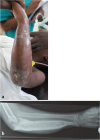Osteomyelitis and Septic Arthritis of the Upper Extremity in Pediatric Patients
- PMID: 39715940
- PMCID: PMC11889307
- DOI: 10.1007/s12178-024-09938-3
Osteomyelitis and Septic Arthritis of the Upper Extremity in Pediatric Patients
Abstract
Purpose of review: For pediatric osteomyelitis and septic arthritis, 10-24% of cases occur in the upper extremity (UE). Due to delays in presentation and diagnosis, UE infections are often more complex and severe than infections of the lower extremity (LE). This review evaluates the literature from the past 6 years related to pediatric osteomyelitis and septic arthritis of the UE and provides a guide for professionals managing these conditions in children.
Recent findings: The shoulder and elbow are the most commonly affected joints, and the humerus is the most commonly affected bone. As with the LE, diagnosis of UE osteoarticular infections is based on clinical evidence, laboratory data, and diagnostic imaging. While Staphylococcus aureus is the primary bacteria identified in UE infections, there is an underappreciation of the burden from Kingella kingae as a causative organism in culture-negative patients where PCR is not performed. Septic joints should be treated with irrigation and debridement urgently, with subsequent antibiotic therapy for a minimum of 2-4 weeks. For acute osteomyelitis without abscess or concomitant septic joints, antibiotic therapy is standard of care. Methicillin-resistant Staphylococcus aureus is associated with more severe infection requiring more surgeries. Various strategies exist for managing segmental bone loss in chronic osteoarticular infections. Osteomyelitis and septic arthritis tend to occur less frequently in the UE than the LE but have a devastating impact on the health and quality of life of children around the world. Complete resolution of disease can be achieved through an individualized approach to antibiotic and operative management. Further study is needed to assess the efficacy of aspiration as a primary treatment strategy in UE joints.
Keywords: Infection; Osteomyelitis; Pediatrics; Septic Arthritis; Upper Extremity.
© 2024. The Author(s).
Conflict of interest statement
Declarations. Ethics Statement: Nnaoma Oji declares that he has no conflict of interest. Coleen Sabatini declares that she has no conflict of interest Human and Animal Rights and Informed Consent: This article does not contain any studies with human or animal subjects performed by any of the authors. Competing Interests: The authors declare no competing interests.
Figures





References
-
- Gigante A, Coppa V, Marinelli M, Giampaolini N, Falcioni D, Specchia N. Acute osteomyelitis and septic arthritis in children: a systematic review of systematic reviews. Eur Rev Med Pharmacol Sci. 2019;23(2 Suppl):145–158. 10.26355/eurrev_201904_17484 - PubMed
-
- Chiappini E, Mastrolia MV, Galli L, De Martino M, Lazzeri S. Septic arthritis in children in resource limited and non-resource limited countries: an update on diagnosis and treatment. Expert Rev Anti Infect Ther. 2016;14(11):1087–96. 10.1080/14787210.2016.1235973. - PubMed
Publication types
LinkOut - more resources
Full Text Sources
Research Materials
Miscellaneous

